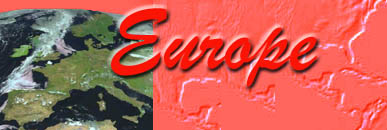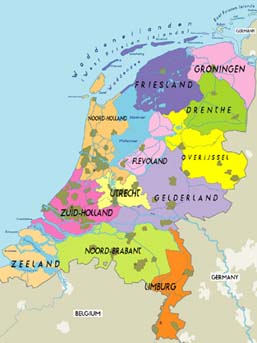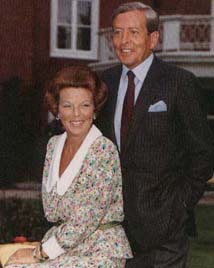

Capital City: Amsterdam |
Text courtesy of Shaula Edskes
Welcome to The Kingdom of the Netherlands!

|
The kingdom of Netherlands is a small country where 16 million people live below sea level. Most people live in the western part of the country. Here are the well-know cities as Amsterdam, the capitol of the Netherlands and the Hague (Den Haag in Dutch) where the government is. This is the part of the country where all the tourists go to.
The eastern part of the country, where Zwolle (Overijssel province) is situated, is more rural and also has a great history. Zwolle, and other cities like Deventer, Kampen and Zutphen, were part of the Hanseatic League (in Dutch it is called "de Hanze"). This was a medieval union between cities in Germany, the Netherlands, Russia, Scandinavia and the Baltic states. In that period there was booming business. Beautiful stone buildings and thick brick walls to protect the city could be built. You can still see the buildings and parts of the wall nowadays.
The Netherlands also has five so-called Wadden islands. Ameland is one of them. It sounds very strange, but these islands can move. That is because the sea takes some sand from one side and brings some to the other. This process is very slow, but in 2005, an island moved so much, that a part of it belongs to another province.
Children in the Netherlands have to go to school when they are 4 years old. They go to "de basisschool" (elementary school) and stay there until they are 12 years old. Every year is "een groep" (a group), so they start in groep 1 and end their elementary school career when they are in groep 8. In that year they make a test called CITO-toets, which gives advice on what level of further education they should do. Because after de basisschool they go to "de middelbare school" (high school) which is divided in three levels: VMBO, which takes 4 years and educates students to be a cook or a mechanic. HAVO takes 5 years and after this you can go to de hogeschool (something like university but on a lower level). VWO takes 6 years and is divided into athenaeum and gymnasium. The difference between these two is that gymnasium offers Latin and Greek. After VWO you can go to the university. There is a big advantage in this system, because when you've finished VMBO you can go to HAVO (last 2 years) and from HAVO to VWO (last 2 years).

|
The Netherlands is a kingdom and that means that there is royalty. The country has a queen: Beatrix. She is the third queen since 1890 and that is quite modern in a world where inheriting the crown is only for the firstborn male. Queen Beatrix was married to Prince Claus, a German prince. It is very strange, but all the 3 spouses of the queens had the title prince instead of king. When Beatrix decides to end her career, her son Willem-Alexander (now called the crown prince) will be king of the Netherlands. He is married to princess Máxima, daughter of a former Argentinean minister. They have two daughters Amalia and Alexia.
On April 30th, the Dutch celebrate the queen's birthday. The national colour of the Netherlands is orange, so everybody is wearing something orange. Other national days are 4th and 5th of May. On May 4th, we commemorate the people who died in World War II and on may 5th we celebrate that the Netherlands was liberated from the war.
People often refer to the Netherlands as "Holland". Even Dutch people use that name when they talk about their country, but it is an incorrect name. Holland are the two provinces in the western part of the Netherlands: Noord(North)-Holland and Zuid(South)-Holland. These two provinces were very powerful during the Middle Ages and the centuries following these times. Foreign countries traded with "Holland" and also the government and the capitol were and are in this part of the country. This might explain why this name is still used for the entire country. Also the 'Dutch Office for Tourism' uses 'Holland' as a brand name because it is so well-known in foreign countries. It is a shame, because the Netherlands has so much more to offer than these two provinces.
Another thing that foreigners have trouble with is the use of the word "Dutch", which indicates that is from the Netherlands. They mix it up with the German word 'Deutsch', which means 'German'. Deutsch and Dutch sound the same, but mean something very different. Language experts are now using Netherlandic instead of Dutch, to avoid confusion.
| Home | Contact Us | Credits | Sitemap |
© 2006 - Imagiverse Educational Consortium